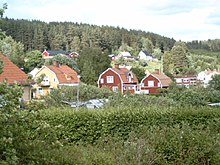Rengsjö
| Rengsjö | ||||
|
||||
| State : | Sweden | |||
| Province (län): | Gävleborg County | |||
| Historical Province (landskap): | Hälsingland | |||
| Municipality : | Bollnas | |||
| Coordinates : | 61 ° 22 ′ N , 16 ° 37 ′ E | |||
| SCB code : | 7252 | |||
| Status: | Crime scene | |||
| Residents : | 245 (December 31, 2015) | |||
| Area : | 0.57 km² | |||
| Population density : | 430 inhabitants / km² | |||
| List of perpetrators in Gävleborg County | ||||
Rengsjö is a locality ( tätort ) in the Swedish province of Gävleborg and the historical province of Hälsingland and is located about 25 km from the virgin coast of the Gulf of Bothnia located between Söderhamn and Bollnäs .
The town center with its village infrastructure is dominated by the Kirchberg to the west and bordered to the east by Östersjön , an approximately 3 km long lake. Hiking trails surround the village, which mainly consists of red wooden houses, while in winter an illuminated cross-country ski run enables winter sports.
Geography and climate
Located north of the 61st parallel, the village is located in the boreal coniferous forest zone with a warm summer continental climate. The landscape is characterized by dense coniferous forests with birch fringes.
The flat, hilly landscape shaped by the Ice Age is 100 m above sea level.
48 lakes enrich the area around the village.
- Annual mean precipitation: 500 mm
- Average temperatures in January: −4 ° C to −11 ° C
- Average temperatures in July: 13 ° C to 15 ° C
Worth seeing
Museum village
Carl von Linné already raved about Hälsingland on his trip to Lapland in 1732, saying that there was "more beautiful and cleaner buildings than elsewhere".
At the western entrance to Rengsjö, Västerby , there is a nationally known museum village Hembygdsby , which with over 30 buildings shows a unique variety of original buildings and with 6820 everyday objects from five centuries houses one of the most extensive collections of rural culture in Sweden.
There are cultural events all year round, especially Swedish folklore performances with traditional costumes and typical music, such as the Hälsinge Hambo .
Linen weaving
In the district of Rengsjö, just 6 km to the west in Trolldalen ( the Troll Valley ), there is an impressive facility of a traditionally water-powered flax mill with numerous buildings in their original state. Växbo kvarn , the Växbo mill.
This unique relic from the early days of industrialization in the sparsely populated region of northern Sweden invites young and old to join in. An interesting tour through various huts in a fairytale environment leaves lasting impressions; the mill from the early 18th century is one of the most popular excursion destinations in Hälsingland.
One plant is assigned to each province in Sweden. The flax is the landscape plant of Hälsingland. The plant that made the former wealth of the agricultural province of Hälsingland possible.
Bullerberget
The ascent to the Bullerberg begins on the southern edge of the village, on the summit of which a lookout tower, which is accessible all year round, invites you to enjoy a magnificent natural experience. The view over vast forests and untouched landscapes, from the flat undulating coastline to the mighty massifs in the west is a worthwhile excursion.
Church history
According to the Hälsingian legend Glysisvallur , the original church of this place is said to have been built in the first half of the 13th century by the smith Brodde von Broddböle on the Ringsbacka - today's cemetery opposite the current building.
The name of this place refers to the burial mound ( Rings Hög ) of the Viking prince Ring, who is said to have his final resting place here. At the same time, this burial mound is the eponym for the place Rengsjö. The name is derived from Rings Hög .
The Sankt-Johanniskirche, named after its patron saint John the Baptist, fell victim to a fire in 1626 and only after 24 years did the long-term new construction begin. In addition to the remains of the old church, a bell from 1630 was also used. Together with a bell made in 1848, its sound can still be heard today with the slow beats that are typical here.
The current sizeable church building with its tall windows under the slightly vaulted ceiling in Gustavian style dates from 1795. The sacristy of the Protestant church, which today belongs to the Bollnäs-Rengsjö assembly, is located in the central church tower of the 43 × 15 m building.
society
Life in the rural area between the small towns of Söderhamn and Bollnäs is characterized by lively club activities. The function of a community hall with weekly social offers is fulfilled by the centrally located clubhouse of the local sports club.
Web links
- Information about the Virgin Coast (Swedish)
- Hometown Club website (Swedish)
- Linen weaving website (Swedish)
- Information about the Sage Glysisvallur (Swedish)
swell
- ↑ a b Statistiska centralbyrån : Land area per Tatort, folkmängd and invånare per square kilometer. Vart femte år 1960 - 2015 (database query)
- ↑ Sveriges meteorologiska och hydrologiska institut

